Photographing the Kansas City Chiefs’ home games throughout the season, if they make it to the Super Bowl, of course I wish them the best. However, there’s a downside to that. If they win the championship, it means I’ll have to cover the parade. A big party? Yes. A lot of work? Oh my, yes!
The night the Chiefs won the AFC Championship, the Associated Press asked if I was available to work the parade if they won the Super Bowl two weeks later. After the first half of the big game, it looked like I’d have Wednesday free. By the end, that was no longer the case.
Three years ago, when the Chiefs beat San Francisco for the trophy, I was part of a four-person team covering the parade for the AP (two staffers and two freelancers). One at the beginning of the parade, me in the middle and two at the end (one near the stage, the other far back in a tower overlooking the scene). This year, with one staffer retired and the other staying in Phoenix for baseball’s spring training, it was just me and another freelancer. How do you cover all of that with just two people? Not easily, but here’s how.
On Monday we worked out the coverage plan. Colin Braley would start near the end of the parade route, allowing him to shoot the buses and players passing by. After that happened, he’d head up to the National World War I Museum and Memorial on the hill above, where he’d have access to an overall view as well as reliable internet to transmit pictures. I’d be credentialed to access the media platform with a view of the stage in front of Union Station. That would allow me to photograph the buses arriving, then the festivities on the stage. There were two big challenges with all of this. The first was that we’d need to be on location at least seven hours ahead of time (I arrived at 6:30am for a 1:45pm event), or risk not finding parking or even be able to get to our spots. The second was being able to send photos.
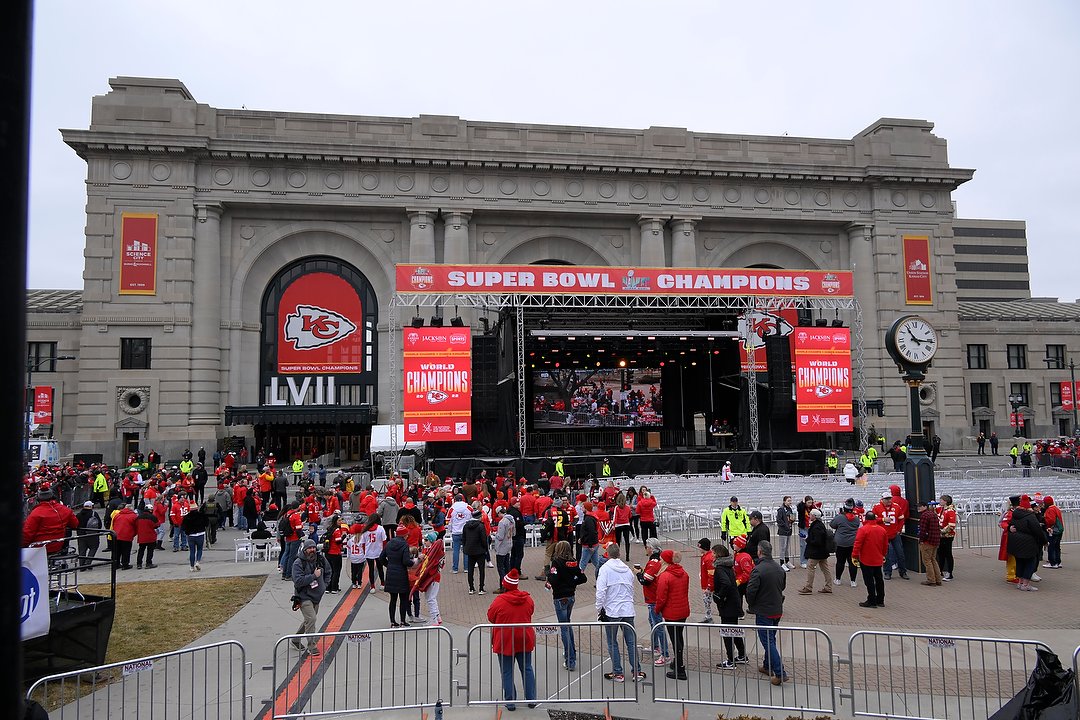
Here’s my view from the media platform that morning. Having scouted it the day before, I knew I’d need a long lens (at least 400mm) to get good photos of the party that would take place up there.
Working for a wire service like the Associated Press means you need to be able to get photos to them ASAP. The days of evening deadlines for newspapers are long gone. Now it’s shoot, send photos immediately, then keep shooting and sending, as often as possible. We knew from our experience at the last Super Bowl parade that once you pack over a half-million people into an area, cell phones would only be good for texting, if you’re lucky. Not enough bandwidth to transmit photos. For Colin, that meant he’d shoot pictures of fans gathering hours before the parade, then hike back up to the Museum to send (they had WiFi for the press to use), then walk back down to cover the actual parade. For me, because of the crowds packed in around the stage area, if I couldn’t get a good enough signal on my phone, I’d not be able to send until it all ended. As expected, the signal strength wasn’t there. But I got lucky in a different way.
An old friend who’s a photographer at the Kansas City Star knew someone at a TV station also on the media platform. They let her connect an ethernet cable to the router they’d installed, so she could get photos out (but no other photographers, so their connection would stay fast enough). And since I was working next to Tammy, bless her heart, she let me use it too. That meant I could download to my laptop, edit, caption, then plug the cable in and send a few photos every hour or two. That kept the editors happy, and helped fill those many hours of waiting in the cold. But I also had another camera in use that day, that I wouldn’t need to send any photos from until much later.

A man carries a portrait of Patrick Mahomes through the crowd during the Kansas City Chiefs’ victory celebration. I sent about a dozen photos like this in the hours before the parade ever arrived. Nikon Z 9, ISO 1250, 1/500 at f/7.1, 24-200mm lens at 72mm.
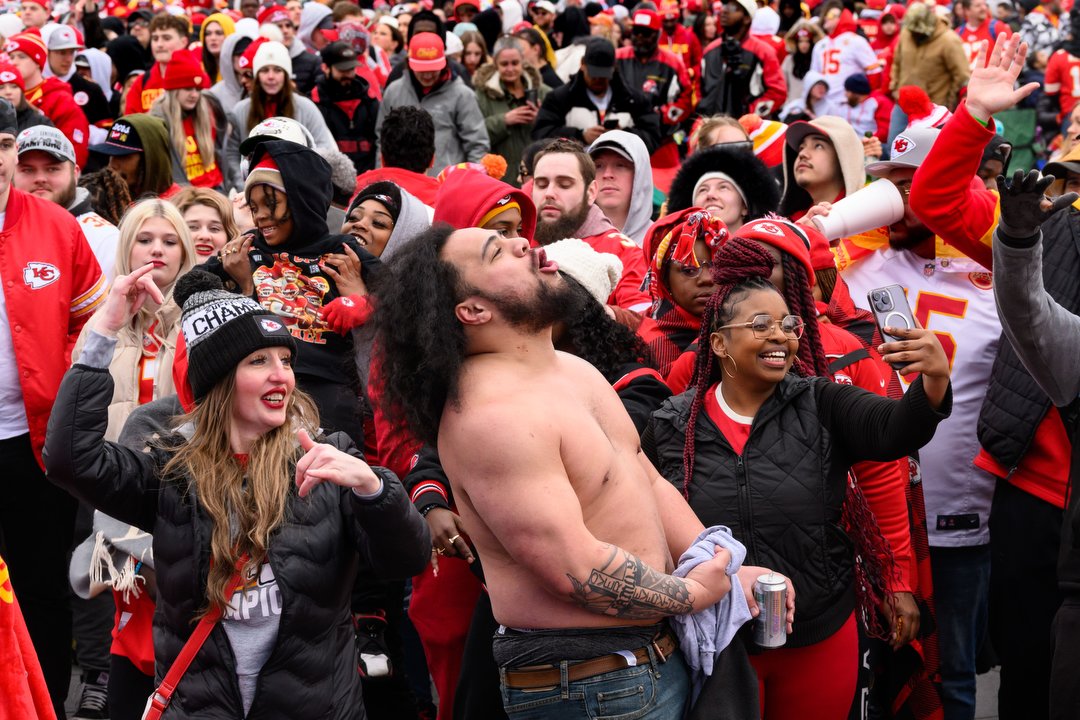
Try to imagine how loud a sound system must be to be heard by hundreds of thousands of people. Well, you’d be wrong. It was even louder. The large, two-level platform I was stationed on was shaking to the beat. The music did entertain the crowd all morning, though, and thank God I always pack earplugs! Even loaned some extras to other photographers. Nikon Z 9, ISO 1400, 1/500 at f/8, 24-120mm lens at 79mm.
The day before the parade I visited the National World War 1 Museum and Memorial to see about setting up a remote camera. The staff there has always been super helpful, so I called and made an appointment. As mentioned, it’s on a hillside overlooking Union Station and downtown, and THE place for an overall photo. The tower is the usual spot to take that picture, but there was nothing I could clamp a camera on up top, and a tripod was sure to get bumped by other media there. When I explained that, my guide asked if I was comfortable with old metal ladders. Now I was intrigued. If I could make it up those two ladders, through a narrow hole in the ceiling and out a small window with my gear, I could set up on the roof of one of their other buildings. And that’s what I did. The next morning, while still dark, I scrambled up there to set up my Nikon and tripod. Using the camera’s built-in intervalometer, I set it to start shooting at 10am, one frame every 20-seconds. The goal was to get that overall shot, yes, but also create a timelapse video. The camera’s battery probably wouldn’t last that long (especially in the cold weather), so I replaced it with a Tether Tools ONsite Relay C Coupler, powered by their 100W 26,800 mAh PD Battery Pack.
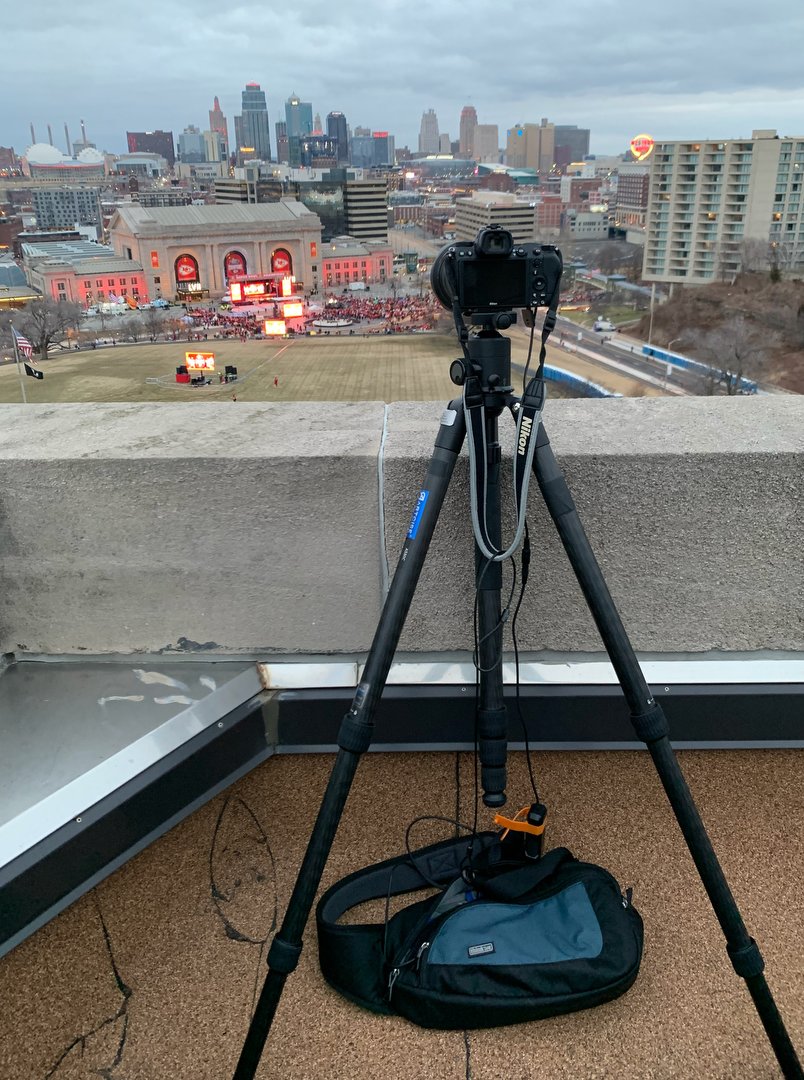
Here’s my Nikon Z 6 II with 24-120mm lens up on that roof, with the Tether Tools ONsite Relay C Coupler, powered by their 100W 26,800 mAh PD Battery Pack, connected to keep it powered and shooting. You can see the resulting timelapse here.
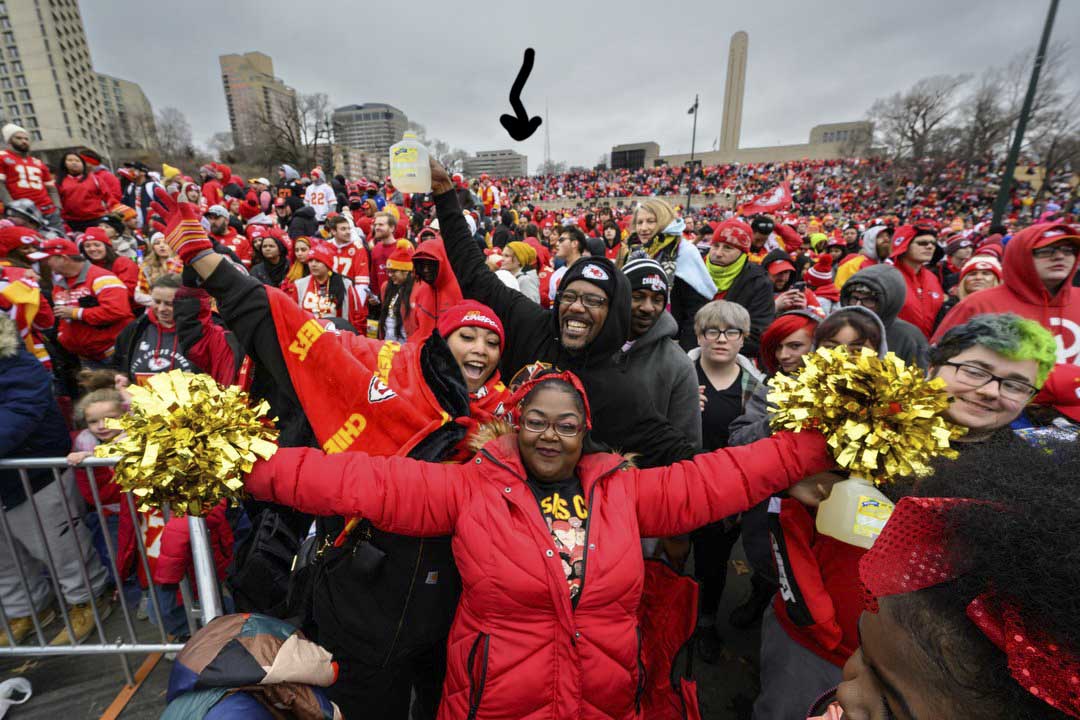
Another crowd shot, with the arrow showing where my remote camera was on top of that building.
Now it was just a matter of getting back to the stage area and waiting a few hours. Actually, more than a few. For most football players, a Super Bowl win is a rare or non-existent event. So they were going to make the most of the day, hopping off the buses regularly to party with their fans. It wasn’t until 2:15pm that the first players made it onto the stage. There were a few speeches, lasting about ten minutes, then just a big celebration. After the speeches I started downloading one card from each camera and kept shooting on the other card (my cameras can each hold two separate cards). By 2:45pm it was pretty much over and I could start transmitting photos again. By 3:30pm I’d packed up and was lugging my gear up to the Museum (too many steps!) to retrieve the remote camera and send more pictures. The museum closed at 5pm, so from there I headed to another location nearby (thanks, Kansas City Star!) to continue sending photos before loading the car and driving home, arriving around 7pm. After sending more photos, I finally took a long, hot shower and then bed. Whew!
Details
Cameras: Two Nikon Z 9 bodies, with white balance set to “Natural Auto” and frame rate at 6 frames/second (to avoid shooting too many images). Never needed to change the battery on either camera, at the end they still showed about 50% power remaining.
Lenses: Nikkor Z 400mm f/2.8 TC, Nikkor 24-200mm f/4-6.3 and Nikkor 14-30mm f/4.
Cards: SanDisk Extreme Pro CFexpress cards, 128GB in slot 1, 64GB in slot 2.
Remote: Nikon Z 6 II with Nikkor Z 24-120mm f/4 lens.
Laptop: Apple MacBook Pro 15-inch.
Images: About 2000 frames taken (not including remote), about 100 sent.
And now a few more photos from the day:
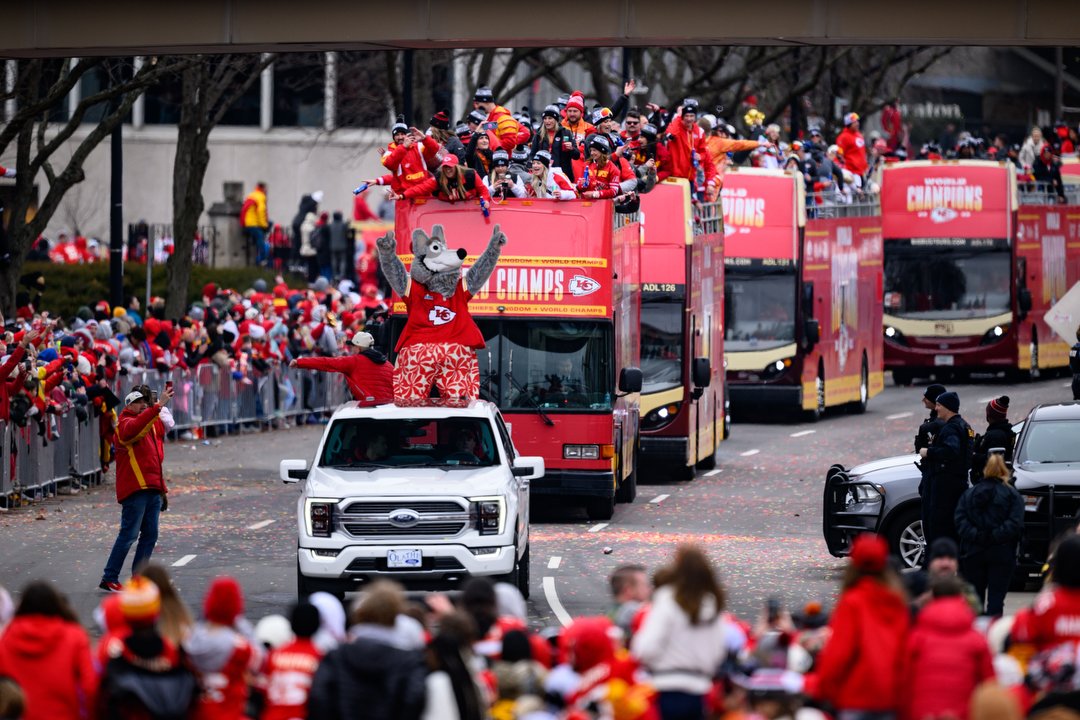
This was my view from the media platform to my right, where the parade arrived from its trip through the city. It was cold out, with a constant 10mph wind making it feel even colder. And that, combined with all the people packed in between me and the buses actually created heat waves. If I were to zoom in on the mascot or players, you’d see they’re a bit out of focus because of that. Nikon Z 9, ISO 220, 1/1250 at f/2.8, Nikkor Z 400mm f/2.8 TC lens.
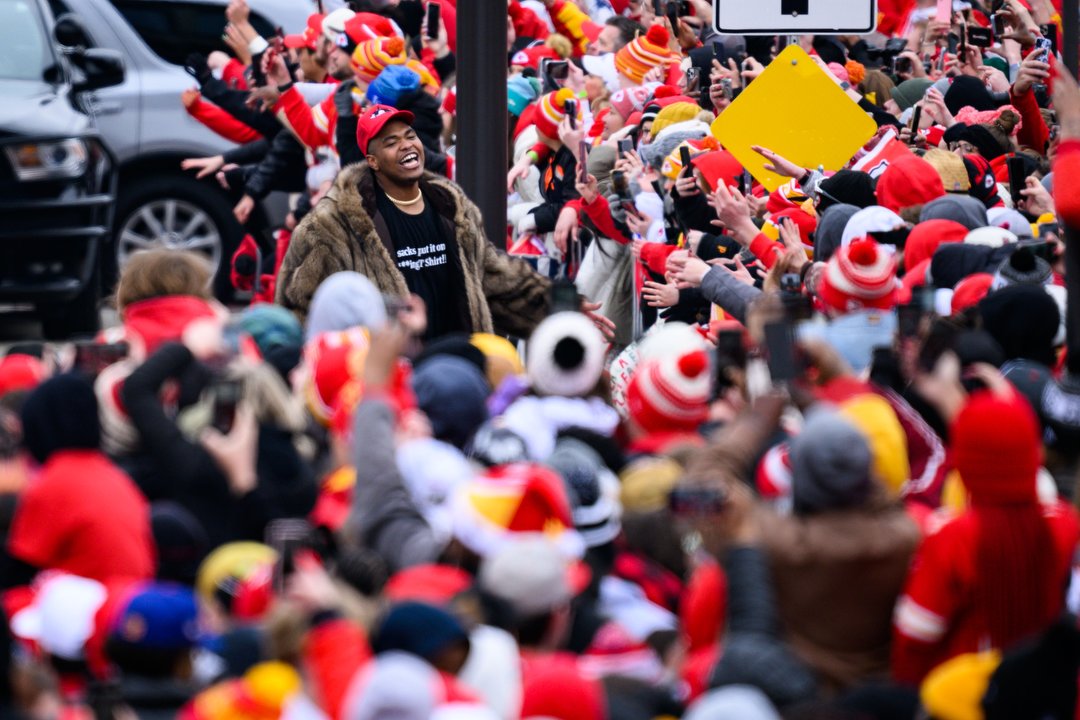
Orlando Brown (in fur coat) was among many players who got off the buses to visit with fans during the Kansas City Chiefs’ victory parade. Nikon Z 9, ISO 500, 1/1250 at f/4, Nikkor Z 400mm f/2.8 TC lens with teleconverter engaged to give me 560mm.
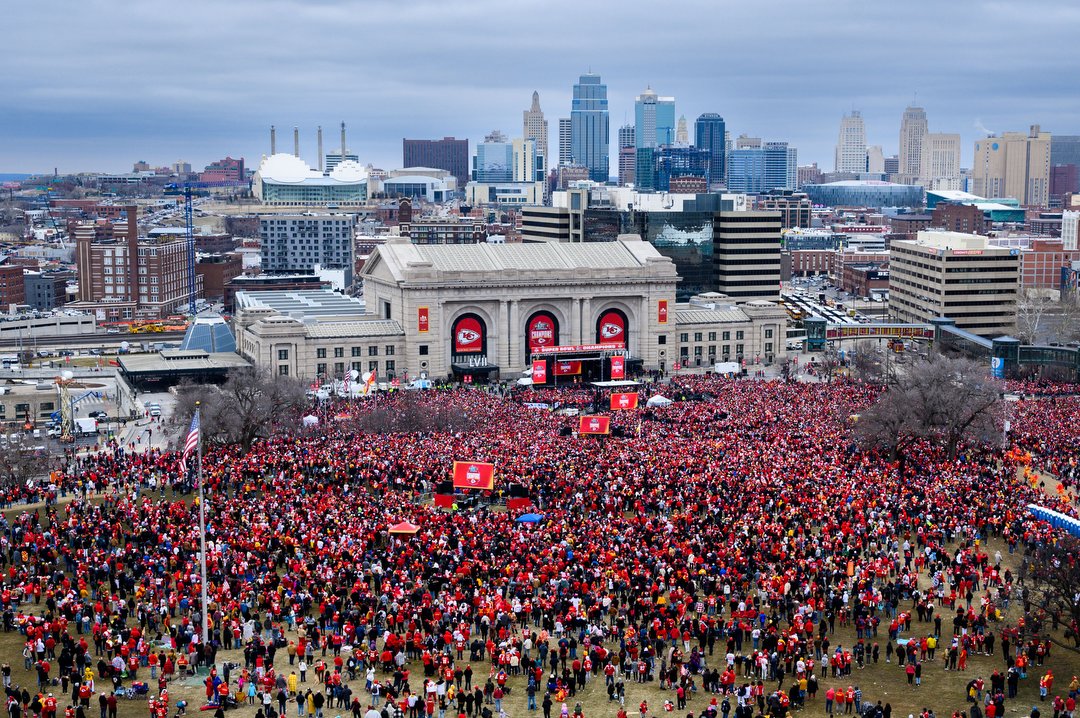
A sea of red greeted the Kansas City Chiefs as they arrived at Union Station. Officials estimated nearly a million people came downtown for the event, including those along the streets leading to the celebration. In this photo from the start of the rally around 2pm, there were probably “only” hundreds of thousands. Nikon Z 6 II, ISO 200, 1/320 at f/8, Z Nikkor 24-120mm lens at 30mm.
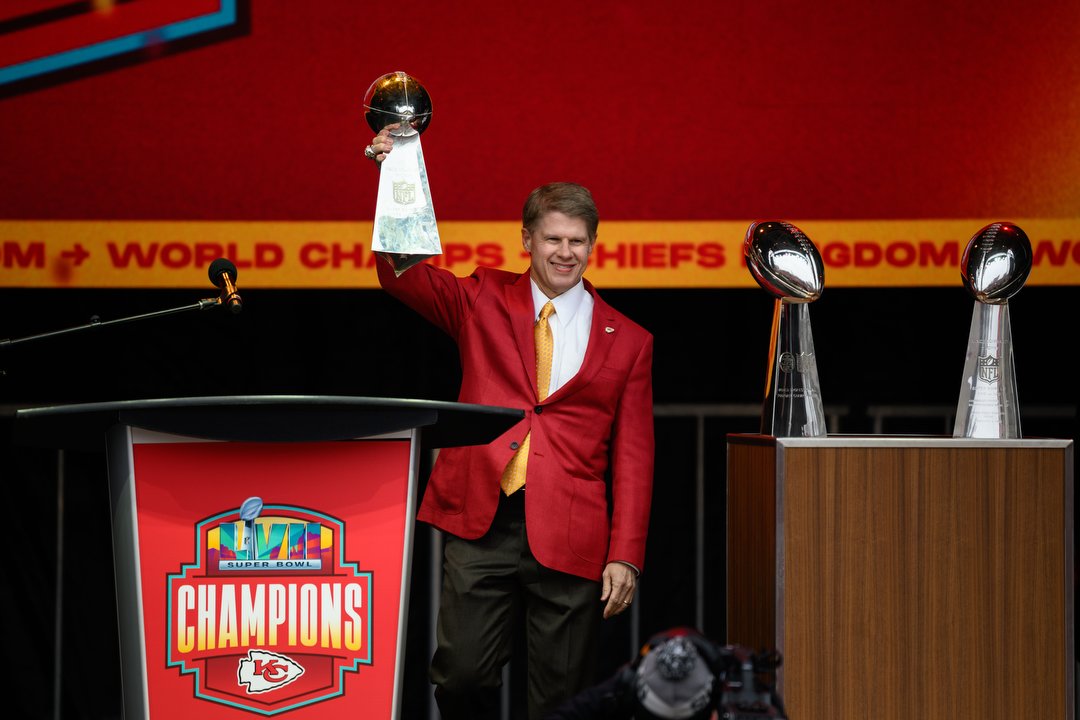 Chiefs Chairman and CEO Clark Hunt brings out the Chiefs’ new Super Bowl trophy to join the first two. Nikon Z 9, ISO250, 1/1000 at f/4, Nikkor Z 400mm f/2.8 TC lens with teleconverter engaged to give me 560mm.[/caption]
Chiefs Chairman and CEO Clark Hunt brings out the Chiefs’ new Super Bowl trophy to join the first two. Nikon Z 9, ISO250, 1/1000 at f/4, Nikkor Z 400mm f/2.8 TC lens with teleconverter engaged to give me 560mm.[/caption]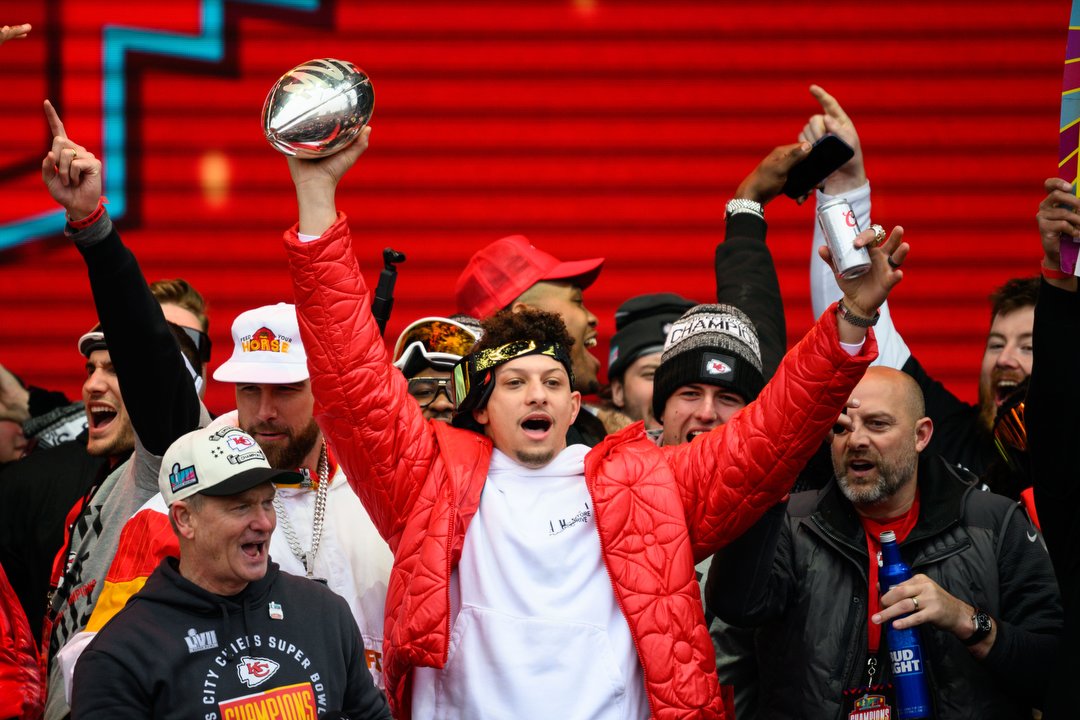
Patrick Mahomes holds up the MVP trophy as he and teammates acknowledge the fans’ cheers. Nikon Z 9, ISO 450, 1/1250 at f/4, Nikkor Z 400mm f/2.8 TC lens with teleconverter engaged to give me 560mm.
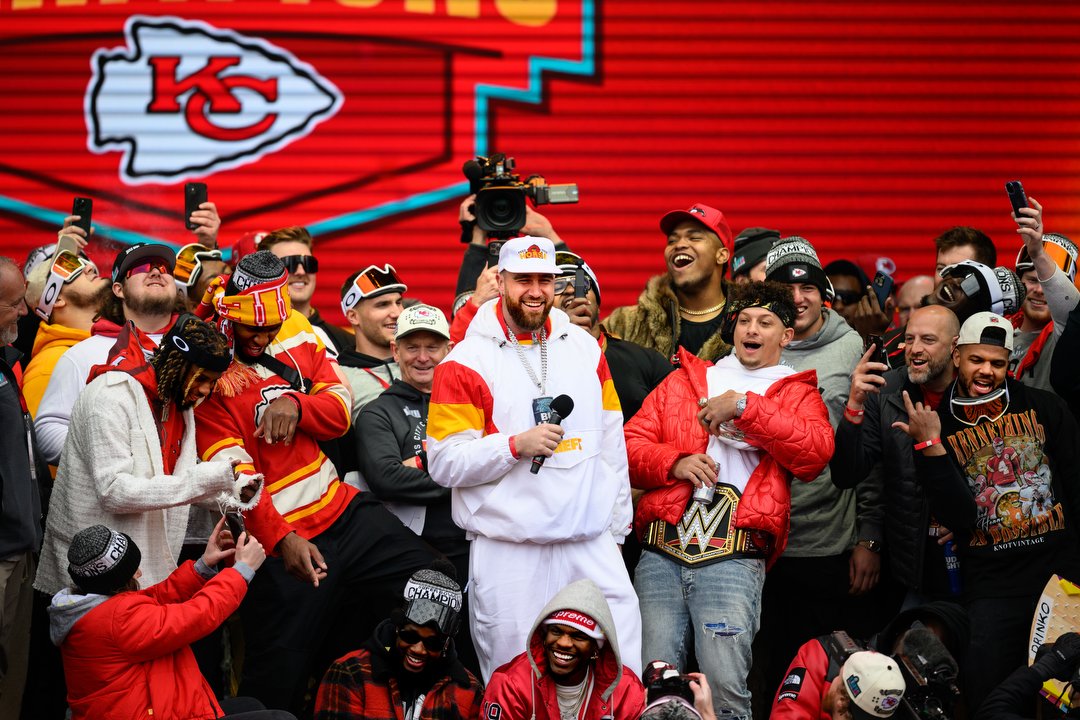
Tight end Travis Kelce entertains his teammates and the crowd with a speech during the Chiefs’ victory celebration. And now he’s booked to host Saturday Night Live on March 4. Nikon Z 9, ISO 250, 1/1250 at f/2.8, Nikkor Z 400mm f/2.8 TC lens.

Patrick Mahomes looks at a photo with a friend while his wife, Brittany Mahomes, and brother, Jackson Mahomes, at right, chat during the Kansas City Chiefs’ victory party. Nikon Z 9, ISO 720, 1/1000 at f/4, Nikkor Z 400mm f/2.8 TC lens with teleconverter engaged to give me 560mm.
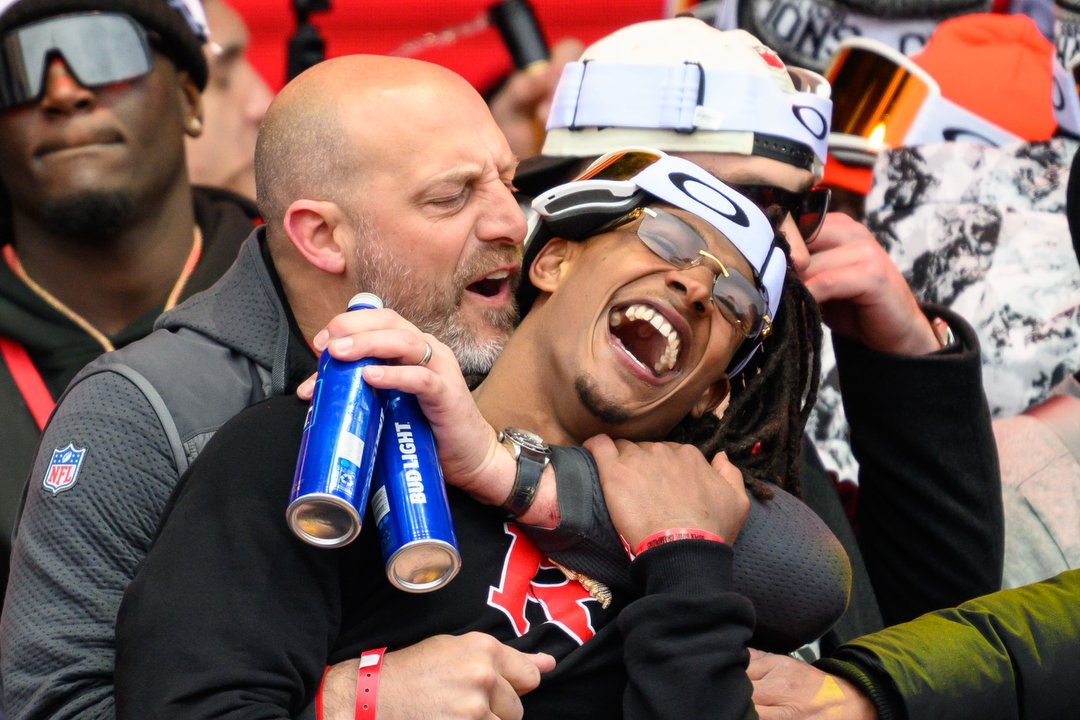
Quarterbacks coach Matt Nagy hugs running back Isiah Pacheco during their victory celebration. Covering the Chiefs all season helped me be able to identify players and coaches, and quickly spell their names correctly. Nikon Z 9, ISO 1100, 1/1250 at f/4, Nikkor Z 400mm f/2.8 TC lens with teleconverter engaged to give me 560mm.
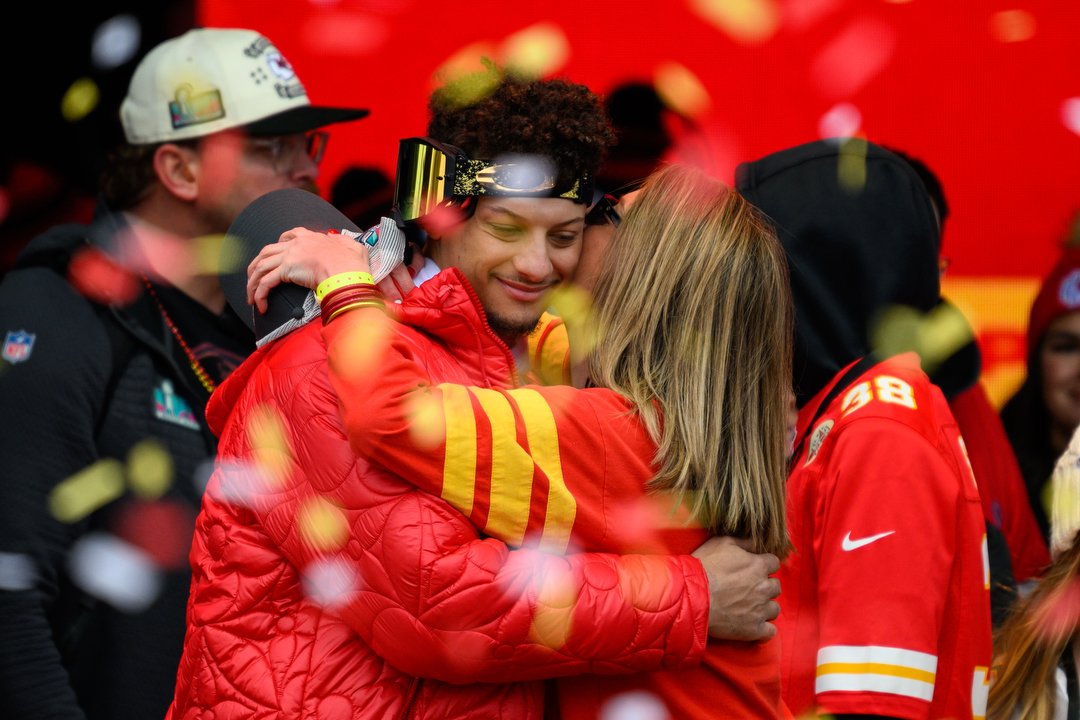
Patrick Mahomes gets a kiss from his mom, Randi Martin, during the celebration. Nikon Z 9, ISO 560, 1/1000 at f/4, Nikkor Z 400mm f/2.8 TC lens with teleconverter engaged to give me 560mm.

Carlos Dunlap, center, and teammates take selfies amidst the sea of confetti at the end of the rally. Nikon Z 9, ISO 360, 1/1250 at f/4, Nikkor Z 400mm f/2.8 TC lens with teleconverter engaged to give me 560mm.
(If you like this story, please share it with your friends and let them know about the links on photography that I post on my business Facebook page. I’m also on Instagram and Twitter, @reedhoffmann. And if you’re curious about the workshops I teach, you can find them here. And, you can subscribe to this blog on my home page.)

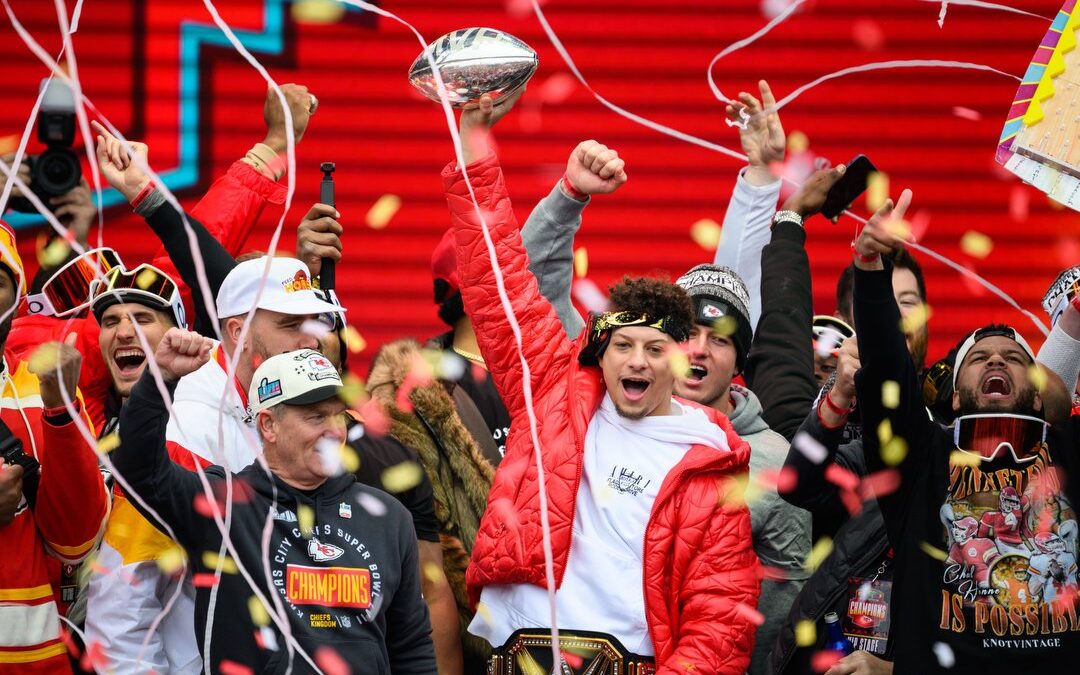
Reed, Great story & terrific photos! The AP lucked out in having you available …climbing a rickety ladder in the dark to get the shot speaks volumes about your dedication to the craft <not to say your balance!
Reed, Great story & terrific photos! The AP lucked out in having you available …climbing a rickety ladder in the dark to get the shot speaks volumes about your dedication to the craft <not to say your balance!